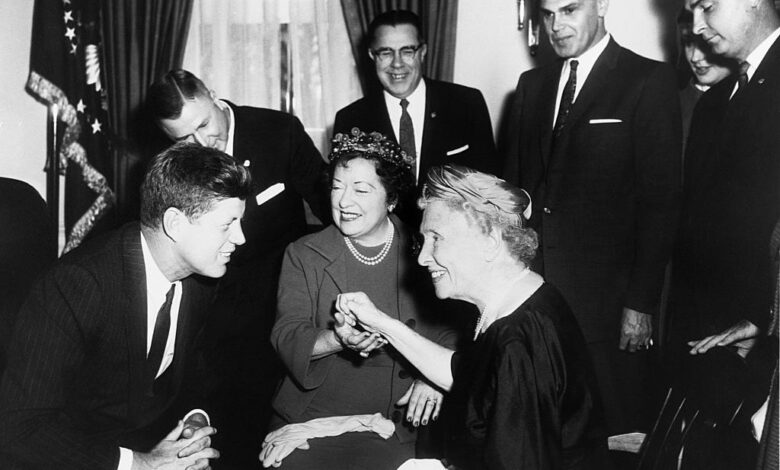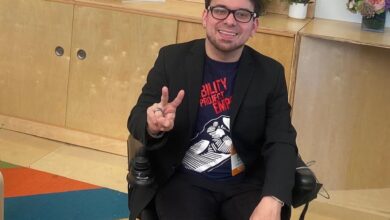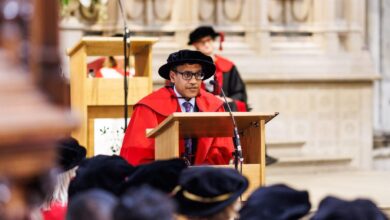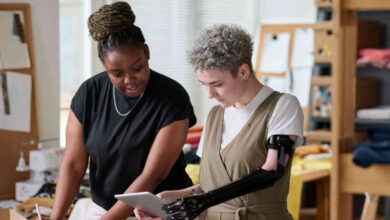The Helen Keller You Didn’t Learn About in School

While the world marked International Day of Persons with Disabilities on Dec. 3, the history of people with disabilities is still not fully taught in schools. In the U.S., if American schoolchildren learn about any person with disabilities, they learn that President Franklin Delano Roosevelt once had polio and used a wheelchair in office, and they learn about Deafblind activist Helen Keller.
Most students learn that Keller, born June 27, 1880, in Tuscumbia, Ala., was left deaf and blind after contracting a high fever at 19 months, and that her teacher Anne Sullivan taught her braille, lip-reading, finger spelling and eventually, how to speak. Students may watch the Oscar-winning 1962 movie The Miracle Worker, which depicts these milestones as miraculous. Keller has become a worldwide symbol for children to overcome any obstacle. At the U.S. Capitol, there is even a bronze statue of 7-year-old Keller at a water pump, inspired by the movie’s depiction of a real milestone in Keller’s life in which she recognizes water coming out of the pump after Sullivan spells the word “water” into the youngster’s hand. However, there is still a great deal about her life and her accomplishments that many people don’t know.
What scholars of disability point out is that when students learn about Helen Keller, they often learn about her efforts to communicate as a child, and not about the work she did as an adult. This limited instruction has implications for how students perceive people with disabilities.
If students learn about any of Keller’s accomplishments as an adult, they learn that she became the first Deafblind graduate of Radcliffe College (now Harvard University) in 1904, and worked for American Foundation for the Blind from the mid-1920s until her death in 1968, advocating for schools for the blind and braille reading materials.
But they don’t learn that she co-founded the American Civil Liberties Union in 1920; that she was an early supporter of the NAACP, and an opponent of lynchings; that she was an early proponent of birth control.
Sascha Cohen, who teaches American Studies at Brandeis University, and wrote the 2015 TIME article “Helen Keller’s Forgotten Radicalism”, argues that Keller’s involvement in workers’ rights can help students understand the roots of the workers’ rights and inequality issues that persist today: “The Progressive Era when she was sort of working politically in different organizations was a period of rapid industrialization and so there were these new conditions in which workers were subjected to this sort of heightened inequality and even danger and risk physically. So she pointed out that a lot of times people went blind from accidents on the shop floor. She saw this real kind of imbalance in power between the workers…and the sort of what we would call the 1% or the very few owners and managers at the top who were exploiting the workers.”
Some of the reason schools don’t teach much about Keller’s adult life is because she was involved in groups that have been perceived as too radical throughout American history. She was a member of the Socialist Party, and corresponded with Eugene Debs, the party’s most prominent member and a five-time presidential candidate. She also read Marx, and her associations with all of these far-left groups landed her on the radar of the FBI, which monitored her for ties to the Communist Party.
However, to some Black disability rights activists, like Anita Cameron, Helen Keller is not radical at all, “just another, despite disabilities, privileged white person,” and yet another example of history telling the story of privileged white Americans. Critics of Helen Keller cite her writings that reflected the popularity of now-dated eugenics theories and her friendship with one of the movement’s supporters Alexander Graham Bell. The American Foundation for the Blind archivist Helen Selsdon says Keller “moved away from that position.”
People with disabilities and activists are pushing for more education on important contributions to U.S. history by people of disabilities, such as the Capitol Crawl. On Mar. 12, 1990, Cameron and dozens of disabled people climbed up the steps of the U.S. Capitol to urge the passage of the Americans with Disabilities Act (ADA). It was considered a moment that raised awareness and helped get the law passed four months later, but one rarely included in public school education.
Thirty years later, one in four Americans have a disability. At least three other states have made efforts to incorporate disability history into school curricula. It’s the law in California and New Jersey to teach the contributions of people with disabilities, and Massachusetts guidelines urge state educators to do the same.
In Sep. 2018, the Texas Board of Education approved a draft of changes to state social studies standards, which included the removal of some historical figures, such as Helen Keller. Shortly after the board opened the draft for public comment, Haben Girma, a Black disability rights lawyer and the first Deafblind Harvard Law School graduate, was one of many who spoke out on the importance of teaching Helen Keller. Girma argued that if Keller’s life is not taught, students might not learn about any history-makers with disabilities. Two months later, the Texas Board of Education approved a revised draft with Keller’s name back in the standards.
Girma agrees that more should be done to teach the full life and career of Helen Keller, and encourages students to read more of her writings to learn more about who she was as an adult. Keller wrote 14 books and more than 475 speeches and essays.
“Since society only portrays Helen Keller as a little girl, a lot of people subconsciously learn to infantilize disabled adults. And I’ve been treated like a child. Many disabled adults have been treated like children,” Girma says. “That makes it difficult to get a job, to be treated with respect, to get good quality education and healthcare as an adult.”
Or just look back at what Keller herself articulated in her 1926 memoir My Key of Life about the impact of inclusive education: “The highest result of education is tolerance.”
TRANSCRIPT
DESCRIPTION: Image of Helen Keller holding book.
GEORGINA KLEEGE: Helen Keller’s image is on the Alabama State quarter.
DESCRIPTION: Image of Alabama State quarter.
GEORGINA KLEEGE: It’s an image taken from a photograph of her reading a braille book. And there’s a motto that says “spirit of courage.” In some sense, that you know you have a woman reading a book
DESCRIPTION: Professor Georgina Kleege speaking.
GEORGINA KLEEGE: and that’s understood to represent courage. And this is not to say that Helen Keller wasn’t a courageous person
DESCRIPTION: Image of a young Helen Keller.
DESCRIPTION: Image of Helen Keller reading.
GEORGINA KLEEGE: but it’s kind of a safe message. Without any sort of controversial overtones to it.
DESCRIPTION: Image of Helen Keller typing.
GEORGINA KLEEGE: It’s like Helen Keller worked hard and she got educated
DESCRIPTION: Image of Helen Keller in cap and gown.
GEORGINA KLEEGE: and that’s all we need to know.
DESCRIPTION: Montage of images of Helen Keller throughout her life.
DESCRIPTION: Montage of disability rights activists.
TEXT: The History You Didn’t Learn
TEXT: The Full Story of Helen Keller
DESCRIPTION: Image of Helen Keller as a child.
NARRATOR: Pretty much everyone learns about Helen Keller in school. From picture books to the movie The Miracle Worker.
DESCRIPTION: Scene from The Miracle Worker.
NARRATOR: She’s a staple in children’s education but we only
DESCRIPTION: Image of water pump.
NARRATOR: learn about one aspect of a multifaceted and complicated person.
DESCRIPTION: Image of Helen Keller.
HABEN GIRMA: The dominant story about Helen Keller is not by Helen Keller.
DESCRIPTION: Disability Rights Lawyer Haben Girma speaking.
HABEN GIRMA: It’s by sighted, hearing people putting forth Helen Keller’s story.
DESCRIPTION: Footage of Haben Girma at the White House.
NARRATOR: Haben Girma is a disability rights lawyer who is also Deafblind.
DESCRIPTION: Image of Haben Girma and her dog.
NARRATOR: For Girma, getting Helen Keller’s story right is personal.
DESCRIPTION: Footage of Helen Keller as a child with her teacher.
HABEN GIRMA: The story focuses on her being 6, 7 years old and things happening to her. People teaching her, people giving her water. She comes across as very passive but if you
DESCRIPTION: Image of Helen Keller.
HABEN GIRMA: learn about her life from her own words, you realize she was an agent of change.
TEXT: “I do not like the world as it is; so I am trying to make it a little more as I want it.” — Helen Keller, 1912
HABEN GIRMA: She advocated for women, people of color.
DESCRIPTION: Montage of images of Helen Keller throughout her life.
HABEN GIRMA: Disability rights mattered to her but the dominant story doesn’t focus on that. Since society only frames her as a little girl,
DESCRIPTION: Film stills from The Miracle Worker.
HABEN GIRMA: a lot of people subconsciously learn to infantilize disabled adults.
DESCRIPTION: Haben Girma speaking.
HABEN GIRMA: That makes it difficult to get a job, to be treated with respect, to get good quality education and healthcare.
DESCRIPTION: Artwork of Helen Keller and teacher.
HABEN GIRMA: That’s not right.
DESCRIPTION: Montage of images of Helen Keller.
NARRATOR: Because we are so focused on Keller as a child, we often miss out on her long life of activism.
DESCRIPTION: Sascha Cohen speaking.
SASCHA COHEN: One of her passions was really the rights of workers and unionists.
DESCRIPTION: Footage of 20th century cities and factories.
SASCHA COHEN: The progressive era when she was working politically in different organizations was a period of rapid industrialization there were these new conditions in which workers were subjected to heightened inequality and even danger and risk physically.
DESCRIPTION: Newspaper reading “Accidents Cause Many Cases Of Blindness”
SASCHA COHEN: She pointed out that a lot of times people went blind from accidents on the shop floor.
TEXT: will have their eyes torn by flying bits of steel
DESCRIPTION: Images of factory workers.
SASCHA COHEN: She saw this exploitation of employees by industrialists, factory owners, corporations. And so she became involved with the IWW,
DESCRIPTION: IWW advertisement.
SASCHA COHEN: the Industrial Workers of the World
DESCRIPTION: Image of the Industrial Workers of the World.
DESCRIPTION: Image of Helen Keller reading.
SASCHA COHEN: She read Marx, she corresponded with Eugene Debs who was the major socialist at the time
DESCRIPTION: Image of Eugene Debs and Ben Hanford.
SASCHA COHEN: and she helped cofound the ACLU
DESCRIPTION: Image of Helen Keller typing.
SASCHA COHEN: which we now sort of associate with freedom of speech. She had a spirit of wanting to help the collective good, rather than individuals on their own.
DESCRIPTION: Images of Helen Keller and the American Foundation for the Blind.
GEORGINA KLEEGE: She found the American Foundation for the Blind, which is an advocacy and education organization. She spent her life from 1925 onward as a spokesperson, and as a fundraiser for that cause.
DESCRIPTION: Helen Selsdon speaking.
HELEN SELSDON: She was an early member of the NAACP.
DESCRIPTION: Footage of Helen Keller.
SASCHA COHEN: She’s condemned lynching. She condemns the racism perpetrated against African Americans. Many people like to think of them as opposed to racism today, it was not so typical to be opposed to racism in 1916 if you were a privileged white woman. It just wasn’t. And she was.
DESCRIPTION: Montage of images of Helen Keller.
HABEN GIRMA: People would often ask her, stop talking about racism, and women’s rights. Just talk about the blind and inspire us about the blind. She found that frustrating and continued to talk anyway.
DESCRIPTION: Helen Keller talking in front of large crowd.
DESCRIPTION: Georgina Kleege speaking.
GEORGINA KLEEGE: When we talk about oppression and prejudice, disability is always sort of off to one side. But for Helen Keller, it was all of a piece.
DESCRIPTION: Montage of images of Helen Keller and confidants.
HABEN GIRMA: You can’t advocate for disability rights if you’re not also advocating for racial justice and gender equality.
DESCRIPTION: Helen Keller receiving a pin at a ceremony.
NARRATOR: Critics of Helen Keller point to one notable exception in her advocacy for people with disabilities.
DESCRIPTION: Image of Helen Keller typing.
NARRATOR: She was once a supporter of eugenics, a now-reviled school of thought that sought to improve human populations by breeding out certain traits, like for example certain disabilities.
DESCRIPTION: Image of Helen Keller typing.
HELEN SELSDON: That’s absolutely true. She did write about eugenics
DESCRIPTION: Helen Selsdon speaking.
HELEN SELSDON: and she was concerned that children with disabilities with severe disabilities would not be able to function in society. I think it was part of that zeitgeist at the time. I think it’s very easy to take history out of context very early on she moved away from that position.
DESCRIPTION: Footage of Helen Keller typing.
DESCRIPTION: Image of Helen Keller.
HELEN SELSDON: And I think she would herself be heartbroken to think that she did not value every life because she absolutely did.
DESCRIPTION: Helen Keller with wheelchair users.
HABEN GIRMA: People need time to grow and learn. We need to forgive people when they acknowledge they’ve made mistakes.
DESCRIPTION: Image of Helen Keller looking out of the window.
DESCRIPTION: Image of Helen Keller at a radio station.
NARRATOR: Still, Helen Keller’s prominence is another reminder of how our American history often focuses on the stories of wealthy white people.
DESCRIPTION: Footage of Helen Keller at event.
DESCRIPTION: Anita Cameron speaking.
ANITA CAMERON: I don’t have a perspective on Helen Keller. She’s just another, despite disabilities, privileged white person.
DESCRIPTION: Images of Anita Cameron demonstrating.
ANITA CAMERON: I am a Black disabled Lesbian who happens to be poor. You know, you want to talk about intersectionalities and marginalizations. I’m looking up from the bottom
DESCRIPTION: Images of Anita Cameron demonstrating.
ANITA CAMERON: and I’m just out here trying to not only fight for the rights of all disabled but wanting to highlight even among disabled, there are those of us whose stories don’t get told.
DESCRIPTION: Archival image of Anita Cameron demonstrating.
NARRATOR: Anita Cameron herself was part of history in 1990 when she and several other activists from the disability rights group, ADAPT, crawled up the steps of the U.S. Capitol Building to demand the passing of the Americans with Disabilities Act.
DESCRIPTION: Footage of activists crawling the steps of the U.S. Capitol chanting “Access now!”
DESCRIPTION: Images of ADAPT demonstration.
NARRATOR: The law that now requires public buildings to have ramps and other accessibility features.
DESCRIPTION: Footage of crowd at ADAPT demonstration.
ANITA CAMERON: On a sunny, hot morning, we gathered up to do our crawl. And that was the only way that we could get there and we were trying to highlight the fact that people with disabilities, we live in second-class citizenship. We kind of went in stealth. It started out as a tour, and when we got into the Rotunda, we just took it over.
DESCRIPTION: Demonstrators shouting “ADA now!” inside the U.S. Capitol.
DESCRIPTION: Police officers approaching demonstrators.
ANITA CAMERON: When it all was said and done, 104 of us were arrested.
DESCRIPTION: Newspaper article reading “Officer Arrest 104 Disabled Protestors”
ANITA CAMERON: I was number 81.
DESCRIPTION: Images of demonstrators being arrested.
ANITA CAMERON: I was in the center of a knot of people who had chained ourselves together.
DESCRIPTION: Images from ADAPT protest.
ANITA CAMERON: The combination of a crawl and the takeover of the rotunda is what got the ADA passed so quickly.
DESCRIPTION: Image of ADA being signed into law by President George H.W. Bush.
DESCRIPTION: Image of ADAPT demonstrators.
NARRATOR: The fight for disability rights is far from over, but the ADA was a milestone achievement. It completely changed the way people with disabilities lived
DESCRIPTION: Newspaper reading “Disabilities Act Forces Sweeping Transit Changes”
NARRATOR: and recognized people with disabilities as people with civil rights. Helen Keller is certainly not the only disability rights champion we should be learning about
DESCRIPTION: Montage of images of Helen Keller and disability rights activists.
NARRATOR: but learning about her work and her activism more fully is a step towards understanding the contributions so many other disabled Americans have made and continue to make to our shared history.
GEORGINA KLEEGE: She was born in 1880, and she died in 1968 and it was a very long life.
DESCRIPTION: Footage of Helen Keller listening to music.
HELEN KELLER: That was beautiful!
DESCRIPTION: Montage footage of Helen Keller.
GEORGINA KLEEGE: So I think when we forget about the causes that she supported it does damage to our understanding about disability.
DESCRIPTION: Montage of images of Helen Keller.
HABEN GIRMA: Some people have a complicated relationship with Helen Keller, because she’s been forced on us a role model to never complain, which is not true. She complained when it was the right thing to do.
DESCRIPTION: Images of disability rights activists. ‘Cause sometimes when things are wrong, you have to complain to create change.
DESCRIPTION: End credits.
More Must-Reads From TIME





